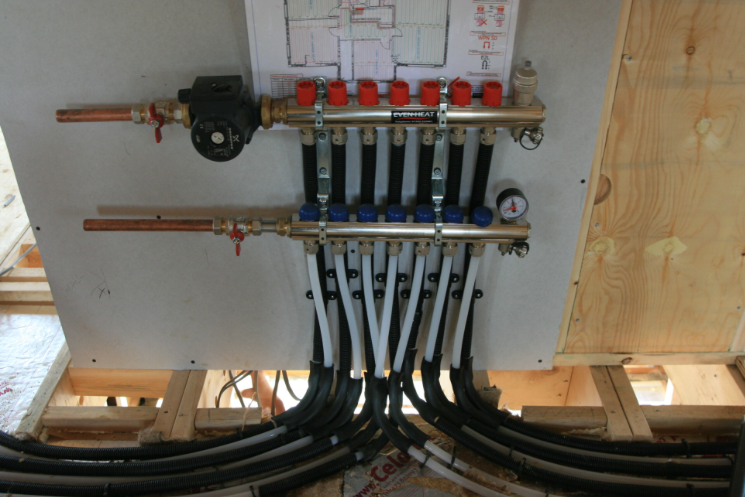Underfloor heating (UFH) is becoming an increasingly popular choice for homeowners in the UK who are seeking an energy-efficient, space-saving, and comfortable way to heat their homes. Whether you’re renovating a property or building from scratch, underfloor heating can offer a sleek and modern alternative to traditional radiators.
In this comprehensive beginner’s guide, we’ll walk you through everything you need to know about how underfloor heating works, the different types available, the benefits, and what you should consider before installing a system in your home.
What is Underfloor Heating?
Underfloor heating is a system that heats a room by warming the floor from beneath, rather than relying on wall-mounted radiators. It transforms your entire floor into a large, invisible radiator, distributing warmth evenly across the space.
Instead of circulating hot air like some conventional systems, UFH emits radiant heat, which rises gradually to warm the entire room evenly and efficiently.
Types of Underfloor Heating Systems
There are two main types of underfloor heating systems: electric (dry) systems and water-based (wet) systems. Each works differently and is suited to different kinds of properties and installations.
1. Electric Underfloor Heating (Dry System)
This system uses a network of electric heating cables or mats installed beneath the floor surface. It connects to the mains electricity and is controlled using a thermostat.
- Heating Mats – Pre-spaced cables laid out in mats, ideal for regular-shaped rooms.
- Loose Wire Systems – Flexible cable that can be laid around obstacles, suited for irregular-shaped areas.
Electric UFH is typically thinner and easier to install in retrofits, making it popular in renovations, bathrooms, and single-room upgrades.
Pros:
- Easier and quicker to install
- Minimal floor height increase
- Suitable for smaller areas
- Quick heating response
Cons:
- More expensive to run than wet systems
- Less efficient for large spaces
2. Water-Based Underfloor Heating (Wet System)
Water-based systems circulate warm water through a network of pipes laid beneath the floor. These are usually connected to a boiler or heat pump and controlled via a manifold and thermostat.
This type of UFH is best suited for new builds or large renovation projects where the floors are being taken up, as it requires more space and planning to install.
Pros:
- Lower running costs
- Ideal for whole-house heating
- Compatible with renewable energy systems (e.g., heat pumps)
- Excellent for energy efficiency
Cons:
- Higher upfront installation cost
- More complex to retrofit
- Installation requires professional expertise
How Does Underfloor Heating Work?
Let’s break down the working principles of underfloor heating.
Heat Distribution
Unlike radiators that create convection currents by heating the air around them, underfloor heating uses radiant heat. This form of heating directly warms up people and objects in the room, similar to the warmth of the sun.
Because the heat rises uniformly from the floor, it avoids the problem of hot and cold spots common with radiators. You get consistent warmth across the entire room.
Thermostat Control
Most underfloor heating systems are controlled by programmable thermostats. These can be wall-mounted or operated via smart home systems. Each room can have its own thermostat, allowing for zoned heating and greater energy efficiency.
Modern systems often feature smart thermostats that can learn your routine, respond to outside temperatures, and be controlled remotely via smartphone apps.

What Flooring Types Work with UFH?
Underfloor heating is compatible with many types of flooring, but the thermal conductivity of the floor covering affects how quickly and efficiently the system heats the room.
Best Flooring Options:
- Tile and Stone – Excellent conductors of heat; ideal for UFH.
- Laminate and Engineered Wood – Suitable if the product is rated for UFH.
- Vinyl and LVT (Luxury Vinyl Tile) – Compatible, but temperature limits must be observed.
Caution With:
- Carpet – Can be used but should have low thermal resistance (TOG rating below 2.5).
- Solid Wood – May expand or contract due to temperature changes; engineered wood is safer.
Always check with the flooring manufacturer for UFH compatibility.
Benefits of Underfloor Heating
There’s a reason underfloor heating is growing in popularity. Here are some of its key advantages.
1. Comfort
The gentle and even heat distribution means no more cold spots or chilly feet. UFH creates a warm, cosy environment that feels luxurious—especially in winter.
2. Energy Efficiency
Underfloor heating operates at lower temperatures than radiators (typically around 27–35°C), which means it uses less energy to achieve the same level of comfort. It’s especially efficient when combined with insulation and renewable heating sources.
3. Space Saving
Without bulky radiators taking up wall space, you have greater freedom in interior design and furniture placement.
4. Low Maintenance
Once installed correctly, underfloor heating requires minimal maintenance. Electric systems have no moving parts, while wet systems have fewer issues if installed professionally.
5. Zoned Heating
With thermostats in each room, you can heat only the spaces you need, when you need them, improving control and lowering energy bills.
Is Underfloor Heating Right for You?
Before committing to an underfloor heating system, consider the following factors.
1. Property Type
- New builds are ideal candidates, especially for wet systems, as the installation can be integrated during construction.
- Renovations and retrofits are better suited to electric systems due to easier installation with minimal disruption.
2. Floor Height
Wet systems can raise the floor level due to the pipework and insulation. This is a key consideration in renovations with fixed door heights.
3. Budget
Electric systems are generally cheaper to install but cost more to run. Wet systems require more investment upfront but are more economical in the long term.
4. Insulation
Good floor insulation is essential to prevent heat loss downward and ensure the system runs efficiently.
Installation Process at a Glance
Here’s a simplified breakdown of what’s involved in a typical underfloor heating installation.
Electric UFH:
- Floor prepared and cleaned
- Heating mats or cables laid and secured
- Thermostat wiring and sensor installed
- System tested
- Floor covering installed over the top
Water UFH:
- Insulation and membrane laid
- Pipework fitted and clipped into place
- Pressure tested to check for leaks
- Floor screed poured to cover pipes
- Curing time before laying the final floor finish
- Thermostat and manifold connected
Both types of systems should always be installed by certified professionals to ensure safety and compliance with UK regulations.
Maintenance and Troubleshooting
Underfloor heating systems are designed to be reliable and long-lasting, especially when installed correctly. However, some common issues might include:
- Uneven heating – May be caused by air pockets in water systems or incorrect floor finishes
- No heat – Could be due to thermostat issues, wiring faults, or low water pressure in wet systems
- Leaks (wet systems) – Rare but potentially serious; professional repair is essential
Regular checks and prompt attention to unusual performance can keep your system running smoothly for decades.
Final Thoughts
Underfloor heating is more than just a luxurious home upgrade—it’s a modern, energy-efficient solution that brings comfort, flexibility, and elegance to any property. Whether you’re opting for a convenient electric system for a bathroom or a full-home water-based installation, understanding how underfloor heating works is the first step to making the right choice for your home.
If you’re considering installing underfloor heating, consult with experienced professionals who can guide you through system design, floor compatibility, and proper installation. With the right setup, your UFH system can provide cosy warmth and energy savings for many years to come.



